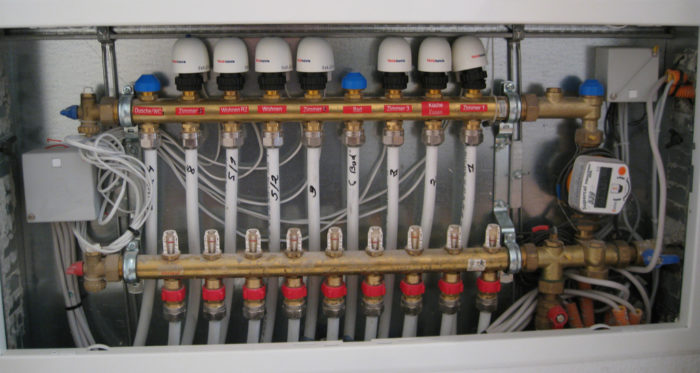
Image Credit: Image #1: Moppet65535 via Flickr
Radiant-floor heating systems are unobtrusive because the plastic tubing that distributes hot water around the house is buried in or under the floor. Homeowners like that. But because there are no air ducts with a radiant-floor system, air conditioning must be added separately.
That’s the situation Lance Peters faces as he plans a new, two-story house in Ottawa (what Peters assumes is the U.S. equivalent of Climate Zone 6 or 7). He’s currently planning to use hydronic in-floor heat on all three levels of the house, plus either a heat-recovery or an energy-recovery ventilator with its own ductwork.
“The house will be superinsulated (~R-40 walls, R-60 attic, R-20-30 below grade) with southern exposure and proper window shading to limit solar radiation,” Peters writes in a Q&A post at GBA. “Finished plans should be around 2,500 square feet. A large portion of the second floor will be open to the first floor (above the living and dining room areas and main staircase), leading me to think ductless minisplits would be a bad idea.”
Peters would like to use the ducts for his heat-recovery ventilator to supply cool air in the summer. “It would be nice to avoid doubling up on the amount of ductwork running through the house,” he says.
Is that plan feasible? That’s the topic for this Q&A Spotlight.
Use an air-source heat pump for both heating and cooling
One of several types of air-source heat pumps would be a good choice for a superinsulated house, GBA senior editor Martin Holladay suggests. There are three basic varieties: a conventional air-source heat pump with ductwork to distribute the conditioned air; a ducted minisplit using a smaller, more localized duct system; or a ductless minisplit.
“Once you’ve installed your air conditioning system, you can use…
Weekly Newsletter
Get building science and energy efficiency advice, plus special offers, in your inbox.

This article is only available to GBA Prime Members
Sign up for a free trial and get instant access to this article as well as GBA’s complete library of premium articles and construction details.
Start Free TrialAlready a member? Log in





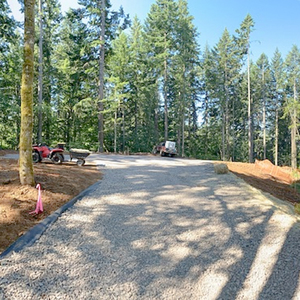
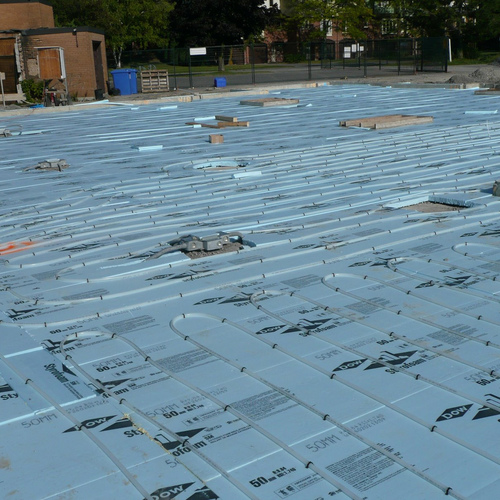
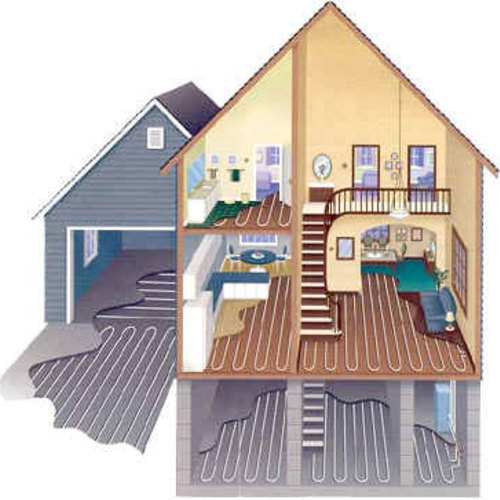
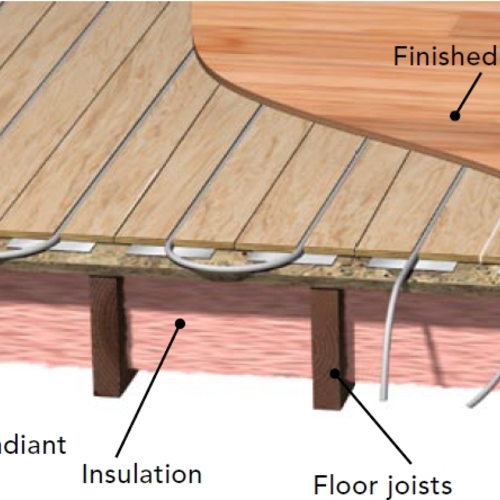






10 Comments
CERV - just the thing for a little AC and a lot of ventilation
Want to distribute AC through your ventilation ductwork? A heat pump ventilator does what an HRV/ERV does, but with a heat pump instead of a passive heat exchanger. In the winter, the air that is supplied to the house can be warmer than the air extracted from the house, and in the summer the supply air can be cooler than house air, and cooler than ambient air. Ductwork is similar to standard ventilation ductwork, but you may need to design to satisfy cooling loads, not just ventilation needs. The capacity, both heating and cooling, is low, so you couldn't heat your house all year with one of these, but for a home with low cooling load, a heat pump ventilator might be just the thing.
Two products I'm aware of - CERV (conditioning energy recovery ventilator) from Build Equinox, and Boreal 12000 from Minotair. The Minotair product is especially designed to manage humidity. The CERV has a recirculation function that pairs well with mini-split heating.
Response to Li Ling Young
Here are links to two relevant articles on these appliances:
A Balanced Ventilation System With a Built-In Heat Pump
Another North American Magic Box
-- Martin Holladay
Adding AC to Radiant Floors
I am building a home in Oklahoma and want to use radiant heat and AC. So, are you suggesting a heat pump for the AC and back up heat? My floor plan is open as described in your blog with 2600 SF.
Response to Beth Freeland
Beth,
This "Q&A Spotlight" article reflects a variety of opinions and viewpoints. My own opinion is that if you want air conditioning, you might as well let your heat pump provide heating as well. That way you don't need to install a radiant floor heating system, and you will save many thousands of dollars.
If your house has an open floor plan, a couple of ductless minisplits (or one ductless minisplit plus a ducted minisplit) will probably meet all of the space heating and air conditioning loads of your home.
For more information on these issues, see these two articles:
All About Radiant Floors
Just Two Minisplits Heat and Cool the Whole House
-- Martin Holladay
Living in a super insulated house
Lance, We have a super insulated house (passive compatible) in a similar climate. We have no active heat source in the house. And no cooling either. We depend on solar radiation (big windows) for heat and cool breezes in the summer for cool. We installed a hydronic system, but it has never been turned on. We depend on high performance windows (www.vettawindows.com) and lots of insulation in the walls (like you are doing).
The problem with using a ductless for heat, is that the OBC does not recognize this unit as a primary heat source, so something else needs to be present. This could be baseboard heaters, for example, which may not be ever used. The other problem with hydronic in a superinsulated house is the lag time. The slab will stay warm for hours after the thermostat has said "off". The problem is overheating the house. In a well built home, a heating system that turns off "now" is far more effective.
Also remember that high wall insulation increases transmittance time (the time required for heat/cold to penetrate the building envelope), and proper shading in the summer, and "summer bypass" on the HRV will all help with the cooling situation at little or no extra cost.
My suggestion? Try the house for a year. Every situation is a bit different, and you may find that your house performs very well sans AC. Or install the tubing for a ductless or hydronic in the event that it might be required in the future.
Good luck on your project.
Alec
Response to Li Ling Young
Why do you say that the Build Equinox CERV pairs well with a mini-split?
We are in the process of trying to decide on a heating system and are finding all of the standard tradeoffs. I would like to hear your opinion on how you would use the CERV with mini-splits. Also, do you have an idea of the average installed cost of the CERV?
Response to Kevin Camfield
Kevin,
I urge you to read A Balanced Ventilation System With a Built-In Heat Pump. In my article, I reported that the installed cost of a CERV system is between $6,500 and $9,000.
-- Martin Holladay
City of Ottawa
One issue with point source heating in Ottawa is that the City is very strict about requiring a heat source in every room with an exterior wall, even if its an open plan. This means that if a ductless mini split on each floor will be able to handle the heating load, something will need to be added to every room.
One way around this is to add heat to the ventilation system with an inline duct heater, and electric radiant floor heating in the rooms without a ventilation air supply diffuser.
Dehumidification using the ventilation air would be excellent, if that is all that is required for us to stay comfortable in Ottawa.
Response to Martin Holladay
Martin,
Thanks for reminding me about the article. Actually, I've read it. Frankly the title was so interesting it is what got me to subscribe to Green Building Advisor. I had forgotten that you had quoted an installation price. I'll go back and have another look.
The Building America team, Alliance for Residential Building Innovation (ARBI) led by the Davis Energy Group (now Frontier Energy) worked with a Tucson builder to engineer a house that used an air-to-water heat pump for radiant floor heating and cooling. An objective was to capture the thermal mass of the slab to limit on-peak cooling energy. The system also fed chilled water to a small air handler that was used for dehumidification during the monsoon season and for supplemental cooling. It was monitored over the course of a year and demonstrated the ability to provide adequate comfort while avoiding peak period cooling. This strategy is clearly limited to mostly dry western climates but that still covers a lot of territory.
Log in or become a member to post a comment.
Sign up Log in